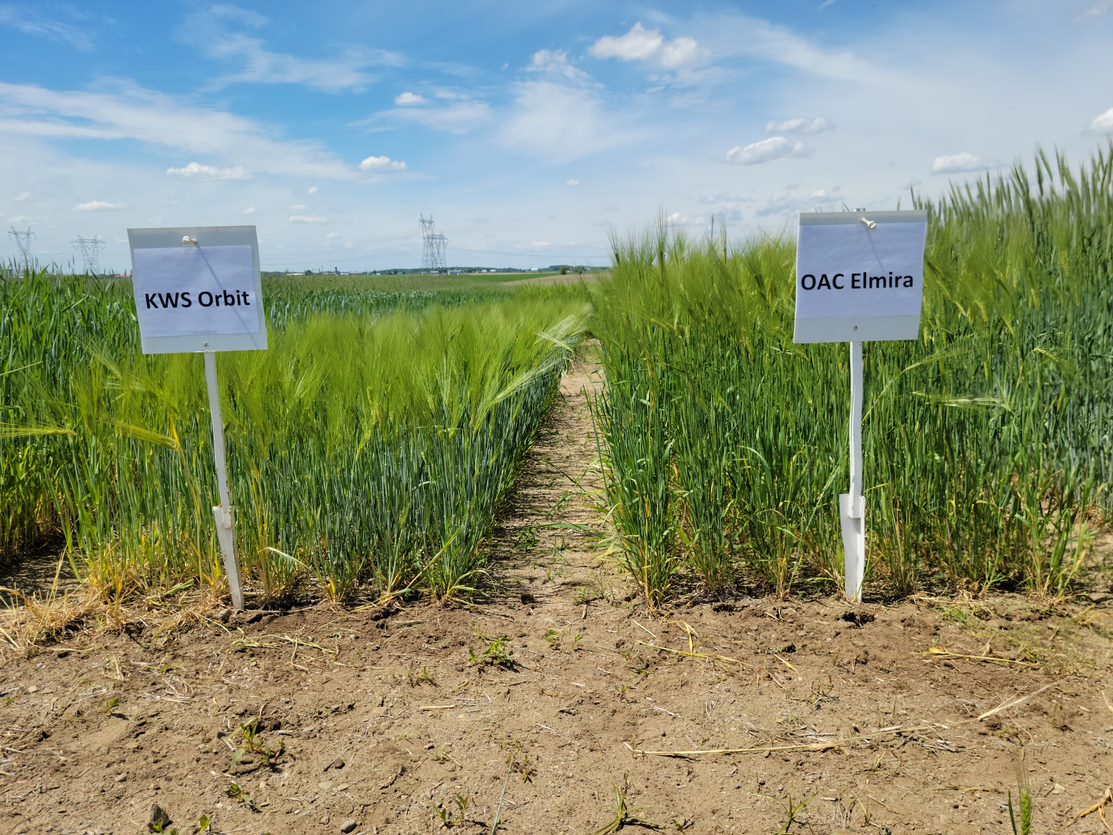KWS Orbit
| Denomination: | 'KWS Orbit' |
|---|---|
| Botanical Name: | Hordeum vulgare |
| Applicant/Holder: |
KWS LOCHOW GMBH Ferdinand-von-Lochow-Str. 5 Bergen 29303 Germany |
| Breeder: |
KWS LOCHOW GMBH, Bergen, Germany |
| Agent in Canada: |
Sollio Agriculture 19235, avenue Saint-Louis Saint-Hyacinthe, Quebec J2T 5J4 Canada Tel: 450-230-6717 |
| Application Date: | 2021-09-13 |
| Provisional Protection:: | 2021-09-13 |
| Application Number: | 21-10717 |
| Grant of Rights Date: | 2024-08-02 |
| Certificate Number: | 7164 |
| Grant of Rights Termination Date: | 2044-08-02 |
Variety Description
Variety used for comparison: 'OAC Elmira'
Summary: At the 5 to 9 tiller stage, the plants of 'KWS Orbit' have a semi-erect growth habit while those of 'OAC Elmira' have a semi-prostrate growth habit. The lower leaf sheath of 'KWS Orbit' has dense pubescence while that of 'OAC Elmira' has absent or very sparse pubescence. At booting, the flag leaf auricles of 'KWS Orbit' have a weak intensity of anthocyanin colouration while those of 'OAC Elmira' have a medium intensity of anthocyanin colouration. The flag leaf sheath of 'KWS Orbit' has a medium degree of glaucosity while that of 'OAC Elmira' has weak glaucosity. The flag leaf of 'KWS Orbit' is shorter than that of 'OAC Elmira'. The plants of 'KWS Orbit' head earlier than those of 'OAC Elmira'. At the end of anthesis, the spike of 'KWS Orbit' has absent or very weak glaucosity while that of 'OAC Elmira' has weak glaucosity. At the beginning of ripening, the plants of 'KWS Orbit' are shorter than those of 'OAC Elmira'. The collar on the spike of 'KWS Orbit' is open shaped while that of 'OAC Elmira' is platform shaped. The rachilla hairs on the kernel of 'KWS' Orbit' are long while those of 'OAC Elmira' are short. Hairs are present on the ventral furrow of the kernel of 'KWS Orbit' while the ventral furrow on the kernel of 'OAC Elmira' is hairless. The kernel of 'KWS Orbit' is long and wide while the kernel of 'OAC Elmira' is of a medium length and width. The 1000 kernel weight of 'KWS Orbit' is greater than that of 'OAC Elmira'.
Description:
YOUNG PLANT: semi-erect growth habit at tillering, dense pubescence on lower leaf sheaths
PLANT: six row, winter feed barley
FLAG LEAF (AT BOOTING): absent or very sparse pubescence on blade and sheath
FLAG LEAF SHEATH: medium glaucosity
AURICLES: weak intensity of anthocyanin colouration at booting, absent or very sparse pubescence on margins
SPIKE: spike emergence occurs early in the season, absent or very weak glaucosity at end of anthesis, semi-erect attitude, open shaped collar, medium density
LEMMA AWNS: weak intensity of anthocyanin colouration of tips, longer than spike length
KERNEL: long rachilla hairs, husk present, hairs present on ventral furrow, long, wide
AGRONOMIC CHARACTERISTICS: good resistance to shattering
Origin & Breeding History: 'KWS Orbit' (experimental designation CFOA2002) was developed using a combination breeding method with double haploid technique. The variety originated from a three-way cross. The initial cross between an experimental line LP 6-826 and the variety 'KWS Meridian' was followed by a cross to the variety 'KWS Tonic' which was conducted in May 2009 at KWS Lochow GMbH in Lower Saxony, Germany. From the F1 generation, double haploids were produced in Wohide, Germany in 2010. The variety was advanced from DH0 to DH3 based on time of head emergence, standability, disease tolerances, plant length, maturity and winterhardiness with one line designated CFOA2002. The line was further advanced based on the above criteria as well as number of tillers and spike size. Breeder seed was established at DH6 in Wetze, Germany in 2015.
Tests & Trials: The comparative trials for 'KWS Orbit' were conducted at Sollio Agriculture in St-Hyacinthe, Quebec in the 2022 and 2023 growing seasons. There were 3 replicates per variety per year arranged in an RCB design. Plots consisted of 7 rows, each row measuring 4.5 metres long with 0.18 metres inter-row spacing. The seeding density was 333 seeds per square metre resulting in approximately 4995 plants per variety per year. Measured characteristics were based on a minimum of 20 measurements per variety per year except for the 1000 kernel weight which was based on 10 measurements per variety per year. Mean differences were significant at the 5% probability level based on a paired Student`s t-test.
Comparison tables for 'KWS Orbit' with reference variety 'OAC Elmira'
Flag leaf length (at booting) (cm)
| 'KWS Orbit' | 'OAC Elmira' | |
|---|---|---|
| mean (2022) | 7.5 9.7 | |
| std. deviation (2022) | 0.7 | 1.6 |
| mean (2023) | 10.9 | 13.3 |
| std. deviation (2023) | 1.2 | 1.2 |
Days to heading (number of days from January 1 to when 50% of heads are fully emerged)
| 'KWS Orbit' | 'OAC Elmira' | |
|---|---|---|
| mean (2022) | 145 | |
| mean (2023) | 152 | 154 |
Plant height (stem plus spike, including awns) (cm)
| 'KWS Orbit' | 'OAC Elmira' | |
|---|---|---|
| mean (2022) | 69.1 | 93.5 |
| std. deviation (2022) | 4.9 | 5.5 |
| mean (2023) | 73.5 | 98.9 |
| std. deviation (2023) | 4.5 | 5.3 |
Kernel weight (grams per 1000 kernels) (g)
| 'KWS Orbit' | 'OAC Elmira' | |
|---|---|---|
| mean (2023) | 50.5 | 33.8 |
| std. deviation (2023) | 0.9 | 0.7 |
| mean (2022) | 47.4 | 34.6 |
| std. deviation (2022) | 0.8 | 0.4 |
Click on image for larger view

Barley: 'KWS Orbit' (left) with reference variety 'OAC Elmira' (right)
Click on image for larger view

Barley: 'KWS Orbit' (left) with reference variety 'OAC Elmira' (right)
Click on image for larger view

Barley: 'KWS Orbit' (left) with reference variety 'OAC Elmira' (right)
- Date modified: